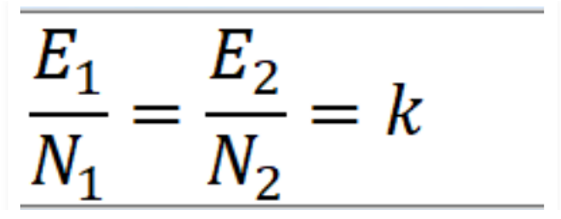
Types Of Transformer: A transformer is a simple but vital electrical device that moves electricity from one circuit to another using electromagnetic induction. Its main job is to either raise the voltage (step up) or lower it (step down) between circuits.
This clever gadget helps in efficient power distribution and is commonly found in power grids and electrical systems worldwide. Without transformers, we wouldn't have a smooth supply of electricity to power our homes and businesses.Suggested - Testing of Transformer
Suggested - Transformer - Electrical Machines Transformers (Formula Notes)
What is Transformer?
A transformer is a fundamental electrical device that transfers electrical energy between different circuits through the principle of electromagnetic induction. It consists of two or more coils, known as windings, linked by a magnetic core. When an alternating current (AC) flows through one of the windings, it creates a changing magnetic field that induces a voltage in the other windings. This enables the transformation of voltage levels while preserving the frequency of the electrical signal.Types of Transformers
Transformers are versatile devices with applications in power generation, distribution, transmission, and electricity consumption. These essential electrical components come in different types, which are classified based on specific factors:- Working voltage range: Transformers are designed to handle different voltage levels, and they can be classified based on the range of voltages they can work with.
- Core material: The core of a transformer can be made from different materials, and this factor helps categorize transformers into various types.
- Winding arrangement: The arrangement of the coils (windings) in a transformer affects its performance, and transformers can be grouped based on this aspect.
- Installation location: Transformers can be installed at various points in an electrical system, and their types may differ depending on where they are placed.
Transformer Types based on Voltage Level
Based on Voltage level, there are two types of Transformers:- Step-up Transformer
- Step-down Transformer
- Step-up Transformers
Step-up Transformer: This type of transformer increases the voltage output compared to the input voltage. It has more turns in the secondary winding than in the primary winding. Step-up transformers are commonly used in power transmission to step up the voltage for efficient long-distance electricity distribution.
- Step-down Transformer
Step-down Transformer: On the other hand, a step-down transformer reduces the voltage output compared to the input voltage. It has fewer turns in the secondary winding than in the primary winding. Step-down transformers are widely used in electrical devices like household appliances, where the voltage needs to be reduced to a safer and more usable level.
These transformers are essential components in electrical systems, ensuring efficient power distribution and helping to match the voltage requirements of various devices and applications.Transformer Types Based on Core material
Transformers come in various types, each using different core materials.- Air Core Transformer
- Iron Core Transformer
- Air Core Transformer: In this type, the primary and secondary windings are linked through the surrounding air. The coils are wound around a non-magnetic material, and there's no iron core involved.
- Iron Core Transformer: Here, the windings are wound around multiple iron plates stacked together. This arrangement creates an efficient pathway for the magnetic flux to flow and generate the required transformation of energy.
Transformer Types Based on Winding Arrangement
- Autotransformer
Autotransformer: An autotransformer is a unique type of transformer that has only one winding wrapped around a laminated core. The special feature of an autotransformer is that the primary and secondary circuits share the same coil.
The term "auto" comes from the Greek language, meaning "self." This design allows the autotransformer to perform both the function of stepping up or stepping down voltage levels, making it efficient and space-saving for certain applications.Transformer Types Based on Install Location
- Power Transformer
- Distribution Transformer
- Measurement Transformers
- Protection Transformers
- Power Transformer: These transformers are utilized in power generation stations because they can handle high voltage applications.
- Distribution Transformer: Mostly found in distribution lines for domestic purposes, these transformers are designed to carry low voltages. They are easy to install and have low magnetic losses.
- Measurement Transformers: Mainly used for measuring voltage, current, and power in electrical systems.
- Protection Transformers: These transformers serve the purpose of protecting components in circuits. They safeguard certain components from voltage fluctuations and other potential hazards.
EMF Equation of Transformer
To derive the EMF (Electromotive Force) equation of a transformer, we can use Faraday's law of electromagnetic induction. Faraday's law states that the induced electromotive force (EMF) in a coil is equal to the rate of change of magnetic flux linking the coil. Consider a transformer with two windings, a primary winding with N1 turns and a secondary winding with N2 turns. When an alternating current (AC) flows through the primary winding, it creates a changing magnetic flux in the transformer's core. Let Φ represent the magnetic flux. According to Faraday's law, the EMF induced in the primary winding (EMF1) is given by: EMF1 = -N1 * (dΦ/dt) Similarly, the EMF induced in the secondary winding (EMF2) is: EMF2 = -N2 * (dΦ/dt) Since the primary and secondary windings share the same magnetic flux, dΦ/dt is the same for both windings. Therefore, we can express the ratio of the EMFs as: EMF1 / EMF2 = N1 / N2 This equation shows the relationship between the number of turns in the primary and secondary windings and the induced electromotive forces in each winding. It illustrates how transformers can step up or step down voltages based on the ratio of turns in their windings.Voltage Transformation Ratio
The voltage transformation ratio, also known as turns ratio, is a crucial parameter in a transformer that defines the relationship between the voltage on the primary winding and the voltage on the secondary winding. It is expressed as the ratio of the number of turns in the primary winding (N1) to the number of turns in the secondary winding (N2):Voltage Transformation Ratio = N1 / N2

K is called the voltage transformation ratio, which is a constant.
Case 1: If N2 > N1, K>1, it is called a step-up transformer.
Case 2: If N2< N1, K<1, it is called a step-down transformer.
For step-up transformers, where the secondary voltage is higher than the primary voltage, the voltage transformation ratio is greater than 1. On the other hand, for step-down transformers, where the secondary voltage is lower than the primary voltage, the voltage transformation ratio is less than 1. The voltage transformation ratio plays a significant role in determining the voltage levels and power distribution in electrical systems. It allows transformers to adapt and transfer electrical energy efficiently between different voltage levels, making it possible to supply electricity to various applications with the appropriate voltage requirements.Application of Transformer
Transformers have a wide range of applications in various industries and electrical systems. Some of the key applications of transformers include:- Power Transmission and Distribution: Transformers are essential components in power grids that transmit electricity over long distances. They step up the voltage at power generation stations for efficient transmission and step it down at substations for safe distribution to homes and businesses.
- Electrical Appliances: Transformers are used in various household appliances like chargers, power adapters, and voltage regulators. They help adapt the voltage levels to suit the requirements of these devices.
- Industrial Applications: Transformers are employed in industries to supply electricity at suitable voltages for heavy machinery and equipment. They ensure a stable power supply and protect sensitive equipment from voltage fluctuations.
- Power Generation: In power plants, transformers are used to step up the generated voltage to the appropriate level for transmission and distribution.
- Renewable Energy: Transformers play a crucial role in renewable energy systems such as solar and wind farms. They help convert the generated electricity to the required voltage for grid integration.
- Railways: Transformers are used in electric trains and trams to step down high-voltage power from overhead lines to suitable levels for train operation.
- Audio Systems: Audio transformers are used in audio equipment to match impedances and provide isolation between different circuits, enhancing audio signal quality.
- Instrumentation: Transformers are utilized in instrumentation circuits for signal conditioning and isolation, providing accurate measurements and protection.
- Lighting Systems: Transformers are used in lighting applications, such as halogen and LED lighting, to adjust voltage levels for proper illumination.
- Electronics: Transformers are essential in power supplies, converting AC to DC voltages for electronic devices like computers, televisions, and smartphones.
Types of Transformer FAQs
What is a transformer, and how does it work?
What are the main types of transformers?
How does a step-up transformer differ from a step-down transformer?
What is the purpose of a transformer in power distribution?
How is a transformer used in electricity transmission?









